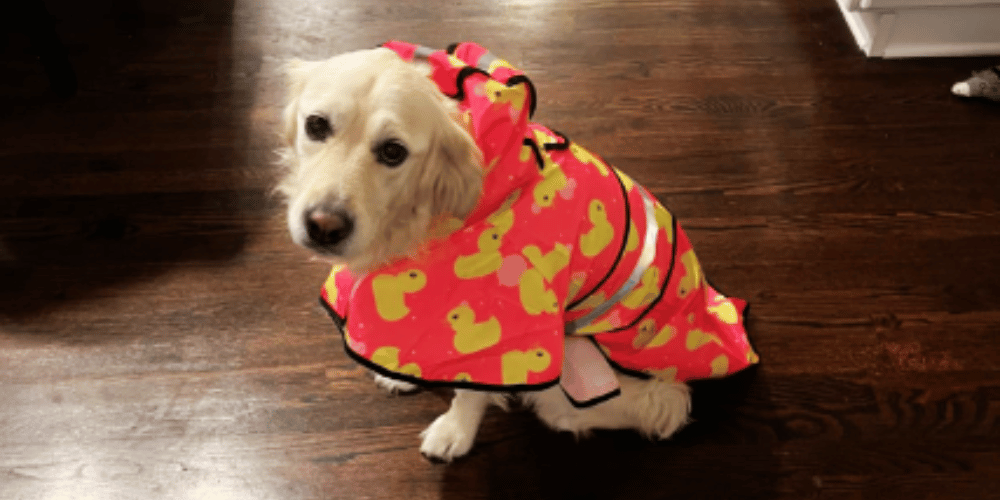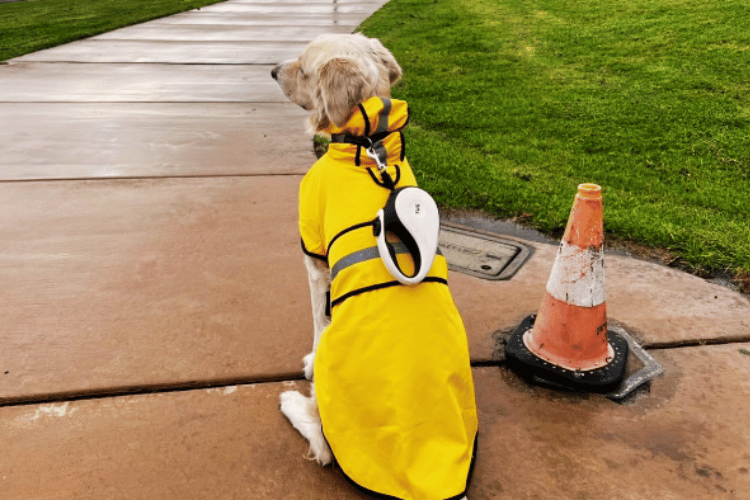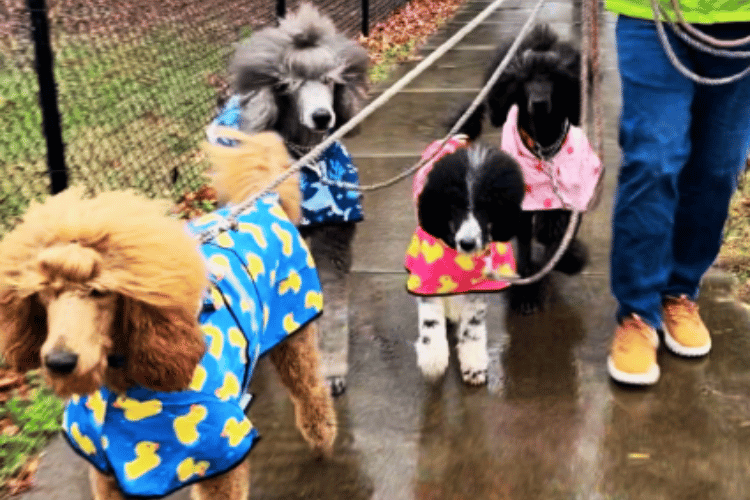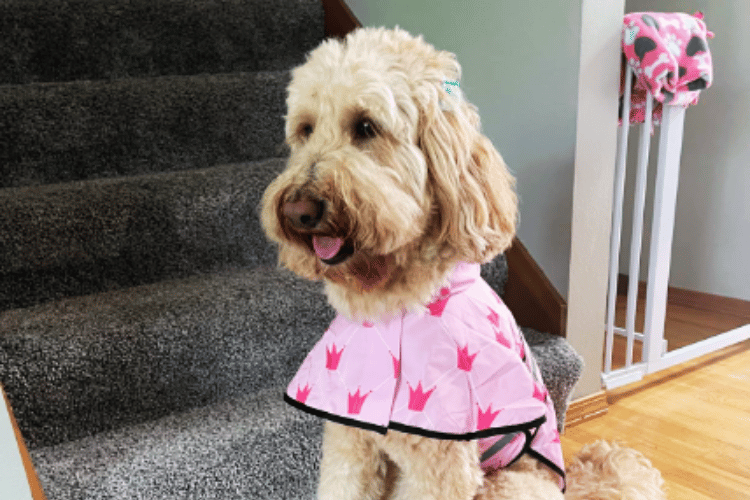Key Takeaways:
- Understanding the benefits and considerations for dressing your dog in a raincoat.
- Identifying which dog breeds and conditions may necessitate the use of raincoats.
- Practical advice on choosing the right raincoat for your canine companion.
When the skies turn grey and the rain starts to pour, many dog owners are faced with a dilemma: should dogs wear raincoats? It's a valid question, especially for those who live in areas prone to wet weather. This informative article will delve into the reasons why a dog raincoat might be more than just a fashion statement, the types of dogs that could benefit from wearing one, and how to select the perfect raincoat to keep your pooch dry and comfortable.

The Case for Dog Raincoats
Rain jackets for dogs are designed with a simple purpose: to keep your dog dry during walks in the rain. But the benefits extend beyond just avoiding the wet dog smell when you return home. For small dogs or those with a compromised immune system, staying dry is not just about comfort; it's about health. Wet fur can rapidly sap the body heat from small breeds or older dogs with arthritic joints, making them vulnerable to the cold. A raincoat can help retain enough heat and protect them from the elements.
Moreover, dog raincoats can prevent the hassle of cleaning up a muddy pooch and your house after a rainy day walk. Water-resistant fabrics and durable material used in dog raincoats can save you time and effort, keeping the mud and wetness contained. For long-haired dogs, a raincoat can also mean less grooming time, as their fur won't pick up debris and tangles as easily when it's protected from the rain.
Does Your Dog Need a Raincoat?
Not all dogs will require the added layer of a raincoat. Many dog breeds are naturally equipped with coats that provide water repellent properties and can shake off the water effectively. However, short-haired dogs or breeds like French Bulldogs may not have enough natural protection against the rain. These dogs can benefit significantly from wearing clothes that help them stay warm and dry.

Older dogs or pups with health issues such as a compromised immune system or arthritic joints should also be considered for raincoats. The additional coverage can help them maintain their body temperature and stay comfortable during walks in cold, wet weather. For dogs that are resistant to going outside when it's raining, a dog coat can make the experience more pleasant, slowly increasing their willingness to venture out for necessary walks.
The Benefits of Raincoats for Different Dog Breeds
When considering whether to invest in a raincoat for your furry friend, it's essential to consider the breed's specific needs. Long haired dogs, for instance, can benefit significantly from raincoats as they prevent their coats from becoming matted and heavy with water.
This not only keeps your dog warm but also makes post-walk cleanups much easier. On the other hand, short haired dogs or short coated breeds may not have a thick fur coat to protect them from the cold rain, making a raincoat a useful tool to help them stay dry and maintain body heat.
For long haired dogs, a raincoat can also reduce the amount of time spent drying and grooming after a wet walk. This is particularly beneficial for owners who may struggle with the demands of maintaining a long-haired breed's coat.
Conversely, short coated breeds often lack the natural insulation that their long-haired counterparts have, so a raincoat can provide that extra layer of warmth, preventing chills and discomfort. In both cases, the use of water resistant fabrics in the construction of the raincoat ensures that your dog remains dry and comfortable, regardless of the weather conditions.

Introducing Your Dog to a Raincoat
Introducing a raincoat to your dog should be a gradual and positive experience. Start by allowing your dog to sniff and investigate the garment to become familiar with it. You can slowly increase the time your dog spends with the raincoat, first draping it over their back without fastening it, then eventually securing it and letting them wear it around the house. This process helps to ensure that your dog's movement isn't restricted and that they remain comfortable and at ease with their new attire.
It's important to pay attention to your dog's age and temperament when introducing a raincoat. Younger dogs might take to it more quickly, while older dogs may require more patience. Always associate the raincoat with positive experiences, such as treats or praise, to create a pleasant association. If your dog seems uncomfortable or resists wearing the raincoat, it's crucial not to force it.
Instead, continue to slowly increase the exposure while ensuring that the raincoat fits well and does not impede your dog's movement. With time and patience, most dogs can learn to appreciate the comfort of a raincoat, especially when they realize it means fewer shivers and less shaking off water after a rainy day walk.
Selecting the Right Raincoat for Your Dog
When choosing a dog rain jacket, it's essential to consider the fit and comfort for your dog's movement. A raincoat should allow for a full range of motion without being too tight or too loose. Look for adjustable straps around the neck, chest, and belly to ensure a snug fit that won't slip off during your walk. Water-resistant fabrics that are also breathable will help keep your pup dry without causing overheating.

Durability is another key factor. A raincoat made from durable material will withstand the wear and tear of regular use, especially if your dog loves to run and play. Features like reflective strips for visibility, leash openings for easy attachment, and machine washability for convenience are also worth considering. Remember, the goal is to keep your dog comfortable and protected, so prioritize function over fashion.
Practical Considerations for Dog Raincoats
When introducing your dog to a raincoat, it's important to do so gradually. Start by letting your dog wear the coat for short periods indoors, slowly increasing the time as they get used to it. Positive reinforcement with treats and praise can help create a positive association with the raincoat. Always monitor your dog's reaction to ensure they're not stressed or uncomfortable.
It's also crucial to maintain your dog's raincoat properly. After each use, rinse off any mud or debris and hang the coat to dry. Regularly check for any signs of wear and tear, and replace the raincoat if it's no longer providing adequate protection. A well-maintained raincoat will serve its purpose for many rainy walks to come.
Summary
In conclusion, whether or not dogs should wear raincoats depends on various factors, including the dog's breed, age, health, and the climate they live in. Raincoats can offer significant benefits, such as keeping your dog dry, warm, and clean, and can be particularly helpful for small breeds, short-coated breeds, and dogs with health issues.
When selecting a raincoat, consider the fit, material, and durability to ensure your dog's comfort and protection. With the right approach, a raincoat can be a valuable addition to your dog's wardrobe, making those wet weather walks more enjoyable for both of you.
FAQ Section
Will a raincoat make my dog too hot?
If you choose a raincoat made from breathable, water-resistant fabrics, it should not cause your dog to overheat. However, always monitor your dog for signs of discomfort and adjust accordingly.
Can all dogs wear raincoats?
Most dogs can wear raincoats, but it's important to introduce them slowly and ensure a proper fit. Some dogs may never adjust to wearing clothes, and in such cases, it's best not to force it.
How do I know if my dog needs a raincoat?
Consider your dog's breed, coat type, age, and health. Dogs that are small, have short fur, are older, or have health issues like a compromised immune system may benefit from wearing a raincoat in wet weather.
Thank you for visiting LegitLists we hope this helps you make a legitimate choice!






